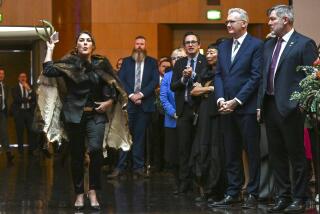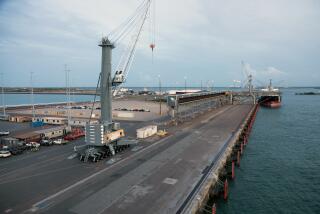PACIFIC REPORT : New Image Down Under : Australia: The government wants to show there’s more than shrimp on the barbie. Reforms aim to lure foreign capital and technology, and to compete globally.
- Share via
Australia, long perceived as an economic outback of cowboys and koala bears, is aiming to transform itself into a manufacturing power and regional gateway to Southeast Asia.
While tourist pitchman Paul Hogan promotes Aussie sun and shrimps, government officials have launched decidedly different efforts to lure foreign capital and technology by trumpeting the nation’s English speakers, Western culture, skilled work force and highly developed infrastructure.
The investment promotion is part of a dramatic turnabout in Australia. It has gone from a highly regulated, protectionist economy to a tough global competitor. By pitching itself as being in Asia but not of Asia, Australia could siphon off not only lucrative investment but also the regional headquarters of foreign firms from places such as Hong Kong.
So far, there are some signs of success. A Conference Board survey released Thursday showed that U.S. investors struck more deals in Australia than in any other Asia-Pacific nation in 1990--beating out the usual No. 1, Japan. The number of new U.S. manufacturing projects totaled 15 last year, three times more than the average in the previous three years. Overall, direct U.S. investment in Australia has doubled since 1973, to $14.5 billion in 1989, U.S. Commerce Department figures show.
Investment from Taiwan, Hong Kong and Japan is also on the rise.
“There is a lot of interest in Australia at the present time,” said Charles Blunt, national director of the U.S. Chamber of Commerce in Australia. “What you’ve got here is a restructuring of the economy, which people recognize as having long-term benefits and ensuring that business prospects will improve. And secondly, particularly in 1990, asset values fell and became attractive purchases.”
Du Pont Co., for instance, acquired a $150-million textile factory last year after the government began reducing subsidies on the highly protected textile industry. Du Pont was approached to turn the firm, Fibremakers, into a profitable nylon materials manufacturer with the eventual ability to export to Asia.
As the harsh winds of global competition buffet Australia, it is shifting to the formula employed by the go-go economies of East Asia: Export manufactured goods with higher value than the raw materials used and pocket the difference. Until recently, Australia has chiefly exported the materials and imported manufactured goods, an impoverishing strategy as commodity prices have declined relative to finished goods.
“Basically Australia has been traditionally known for the things we grow and the things we dig up--mining and farming. But over the last decade or so, we’ve seen the prices for those types of products decline, so our export earnings have not kept up with our import costs,” said Peter Pond, an official with the Australia Trade Commission in Canberra.
“Australia is moving away from being a farm and a quarry to where the growth is in the world economy--manufacturing,” Pond said.
To reorder the nation’s economy, the government is trying to attract foreign investment in two areas. One is industries that add value to Australia’s raw materials. For instance, processing food and minerals, turning wool and cotton into textiles, and tanning leather.
“We want to ship leather instead of hides. We ship a lot of wheat, but we’d like to ship biscuits and bread and dough,” Pond said.
The second area is high technology, such as biotechnology, aerospace and medical equipment.
Federal and state governments have tried to stimulate high technology by offering incentives such as a 150% writeoff on research and development expenses.
In the past year, the Australian government has shifted its efforts from general promotion to raising the Australian profile to specific matchmaking between companies. The campaign began in 1987, and the Australian government has redoubled its investment attraction efforts since February, 1989, recently sending special trade commissioners to New York, Paris, Frankfurt, Tokyo and Seoul. Australian officials are trying to persuade potential investors that it is easier and more comfortable to do business in Australia than other Pacific Rim nations, said Pond of the Australia Trade Commission.
“An American or European company may not wish to locate in a nation with a foreign culture like the Philippines or Malaysia but prefer a country with a stable political system, where English is the language, where business rules are understood, and use that as a base to export,” Pond said.
“About two-thirds of Australia’s exports go to Asia, and that’s evidence that we have the expertise to access those markets. Australia is well-positioned to be a gateway for access to the burgeoning markets of the Asia-Pacific region,” said Richard Sedden, Australia’s top investment pitchman in the United States as the New York-based Australian Investment Commissioner for North America.
Other selling points: an educated and skilled work force, the best telecommunications system in Southeast Asia and a developed infrastructure, such as airports, container ports and railways.
But changing Australia’s image, most recently promoted as a land of sun and fun by “Crocodile Dundee” Hogan, hasn’t been easy.
“People think of us as cowboys and throwing shrimps on the barbie and nothing else. There is the image of the Great Barrier Reef and a lovely place to visit but not a lovely place to set up factories,” Pond said.
The second major image Australian officials have had to overcome is one of constant labor strife, rigid centralization and a closed, protected market. The former British colony has traditionally followed what one scholar called “English socialism, anti-capitalism, a feeling on the part of workers of ‘us vs. them.’ ”
“The reputation of Australia is a country in which labor disputation is constant and very high. In the eyes of American business, this throws an element of real unpredictability into economic calculations to decide whether this is an investment worth making,” said Richard Baker, research scholar with the East-West Center, who served as political section head of the U.S. Embassy in Canberra from 1984 to 1987.
After the election of Prime Minister Bob Hawke, himself a former labor leader, the government struck a deal with unions called “the Accord” in which wage and benefits were tied to productivity. Still, labor remains an impediment to Western investment, said Mike Van Horn, president of Pacific Rim Consortium, a San Francisco-area consulting firm that advises U.S. firms on Asian investments.
Van Horn said too many labor contracts in Australia forbid overtime, slowing productivity.
“One Australian executive told me that Australia has been known as the ‘lucky country,’ ” Van Horn said. “He said many investors now consider Australia to be the ‘lazy country.’ ”
Despite such concerns, Pond said, the promotion efforts have helped lure some U.S. makers of pharmaceuticals and scientific instruments, such as Medtronics Inc., to Australia. Other large U.S. manufacturers that invested in Australia last year appeared to do so independent of the government’s promotion efforts, however.
Arvin Industries entered a joint venture with Tubemakers of Australia last year mainly to supply Nissan, Ford and Toyota auto makers with exhaust systems for the domestic market. ConAgra Inc.’s joint venture with an Australian meat processor will supply beef, mutton and lamb to the domestic market and export markets of the United States, Europe and Asia. For Borden Inc., the acquisition of a food packaging business was one of a series of investments to further expand its global competitiveness. The firm also has production facilities in Malaysia and the Philippines.
For many U.S. firms, Australia is familiar turf. The United States is Australia’s largest foreign investor after the United Kingdom and ahead of Japan. The estimated 800 U.S. firms operating there represent the highest American investment in the Pacific Rim outside Japan.
Cumulative direct U.S. investment has grown to $14.5 billion in 1989 from $11.1 billion in 1987 and $6 billion in 1973, according to U.S. Department of Commerce figures.
Overall, the yearly increase in direct foreign investment has grown to $13.5 billion in 1989 from $3.3 billion in 1985, according to Australian government figures.
But officials say the floundering Australian economy, along with the Gulf War, have put a crimp on efforts to lure even more investment. The economy dipped into recession around June, 1990.
Much of the economic slide has been attributed to the government’s tight money policies, pursued to reduce the inflation rate, which hovered around 8% at the beginning of 1990.
Still, Australia’s problems spell opportunity for foreign investors. Many Australian companies have not been able to get the financing they need to expand or modernize, economists say. For that reason, some have been uncompetitive and have been willing to put their operations on the block, Van Horn said.
He added that some companies in Australia are selling for about one-fifth of the price what the same enterprise would fetch in the United States.
“It’s a buyer’s market,” Van Horn said. “I would say U.S. investment in Australia will pick up. There is also growing investment interest on the part of investors in Japan, Taiwan and Hong Kong as well.”
AUSTRALIA’S MAJOR REFORMS
* Deregulated financial industry
* Began restructuring auto, steel, textile industries.
* Reducing tariffs on manufactured goods.
* Removed quotas for textiles and motor vehicles.
* Dismantled most agricultural protections.
Source: Richard Baker, East-West Center
NEW PLAYERS U.S. companies making new manufacturing investments in Australia in 1990. JV: joint venture; A: acquisition.
Company Type Arvin Industries JV Borden Inc. A Coca-Cola Co. A Conagra Inc. A Conagra Inc. JV Du Pont Co. A Federal Mogul A H.J. Heinz New Manville Corp. A McGraw-Hill Inc. A Mobil Oil Corp. A Nalco Chemical Co. A Outboard Marine Corp. A Outboard Marine Corp. A Tyco Laboratories Inc. A
More to Read
Sign up for Essential California
The most important California stories and recommendations in your inbox every morning.
You may occasionally receive promotional content from the Los Angeles Times.













